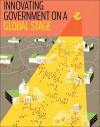The Open Government Partnership’s (OGP’s) commitment to a partnership between government and civil society at international and national levels—and its accent on domestic as opposed to international accountability—distinguishes it from many international initiatives promoting open government.
Innovating Government on a Global Stage

This special supplement includes nine articles produced for the Open Government Partnership. OGP is a new effort to foster greater transparency and accountability, improve governance, and increase civic engagement worldwide.
-
Transforming Multilateralism: Innovation on a Global Stage
-
Shattering Decades of Diplomatic Protocol
-
Innovating Modern Democracy, in Brazil and Globally
-
Advocacy from the Inside: The Role of Civil Society
-
The UK’s Transparency Agenda
-
Tanzania’s Transparency Agenda
-
Philanthropy Can Catalyze an Open Government Movement
-
India in Open Government and Open Government in India
-
Building a Global Norm on Open Government
As a September 2012 survey of civil society organizations (CSOs) engaged in OGP shows, there is widespread recognition that OGP represents a great opportunity for leveraging transparency and accountability in countries around the world. All the organizations are energized by the early victories that have been achieved, such as the new Access to Information Law in Brazil and greater transparency of military and police budgets in the Philippines. Most also acknowledge that OGP has helped to bring together civil society advocates working across multiple sectors, helping to break through the silos that often undermine civil society effectiveness. But many CSOs are still cautious about OGP, particularly about how partnerships with governments will play out at the country level.
What can we learn from the experience of the eight founding countries about effective CSO-government collaboration?
At the international level, the partnership between CSOs and governments on the steering committee is working well. The two parties’ candid and often vigorous discussions—as well as their willingness to challenge one another (between and within caucuses)—has significantly refined the overarching concept and policies driving the initiative.
CSO participation in OGP at the international level, in turn, has supported stronger country-level processes and outcomes in many of the eight founding countries. As Juan Pardinas, CEO of the Mexican Institute for Competitiveness and a colleague on the steering committee, argues, Mexican civil society was initially disappointed by the lack of consultation and weak commitments in the initial Mexican action plan. But having Mexican civil society and government representatives on the steering committee—together with strong CSOs on the ground—empowered reformers in the government. The result was a redrafted, stronger Mexican action plan, which included exciting progress on consumer protection and greatly expanded access to school budget information.
Civil society organization participation in OGP at the international level has supported stronger processes and outcomes at the country level.
Tom Blanton, director of the National Security Archive at George Washington University and a steering committee member from US civil society, tells a similar story. OGP’s design process offered an opportunity to marshal pressure on the US government to close the gap between strong open government policy commitments and slow or weak implementation of them. The US action plan ultimately reflected several CSO priorities, such as US participation in the Extractive Industries Transparency Initiative.
The key to these successes was a sophisticated insider-outsider strategy adopted by experienced activists from countries with robust civil societies. The test we faced as CSOs on OGP’s Steering Committee was to help incubate a powerful idea while staying connected to our civil society partners. Pardinas and Blanton, among others, avoided this potential problem by combining active engagement on the steering committee with building or maintaining strong relationships to local civil society coalitions. In Mexico, a new coalition was assembled; in the United States an existing coalition—OpenTheGovernment.org—was adapted for this purpose.
How might these initial experiences translate into effective civil society engagement in the broader set of OGP countries?
First, our experiences to date show that productive collaboration between governments and CSOs in OGP is certainly possible. Indonesia and the Philippines, for example, have included civil society in the action plan drafting committee. Mexico and the United States have multi-stakeholder teams at both the national and sector levels driving action plan development. Still, in many countries government has yet to find the appropriate balance of roles and is more hesitant about working with civil society. This challenge is as great in several European countries as in Africa and Latin America.
Second, a critical ally role is not an entirely new concept, particularly for organizations in countries with a vigorous civil society. But in many parts of the world, where strictly adversarial roles between governments and CSOs have been the norm, or where civil society is less robust, such a dual role for civil society will be quite new and challenging.
Third, and perhaps the greatest challenge for both civil society and government going forward, will be reaching out within participating countries to involve those who live outside urban areas, speak in local dialects, and have little access to the Internet. Both governments and CSOs will have to dig deep to transform open government into a cause that will galvanize the participation of the poorest and drive real development.
OGP’s progress to date in piloting a new approach to CSO-government collaboration makes me optimistic that we will meet these challenges at the country level.
Support SSIR’s coverage of cross-sector solutions to global challenges.
Help us further the reach of innovative ideas. Donate today.
Read more stories by Warren Krafchik.

